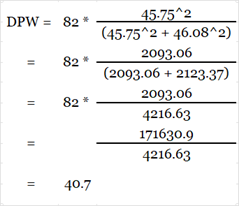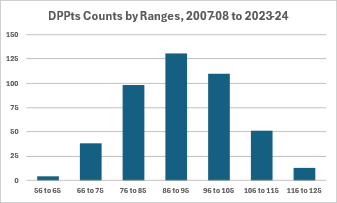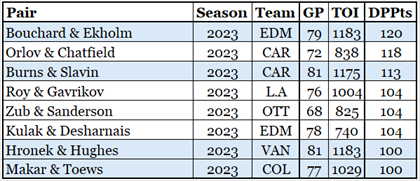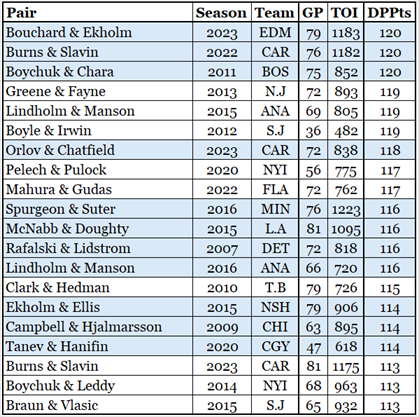I was wandering through NaturalStatTrick.com, looking at the various reports they provide, and got into their Defensive Pairs report. This got me thinking: who are the best defensive pairs right now? Which pairs had the best seasons ever? And which defensemen had the best long-term partnership?
Defensive Pairs: Naming Convention
Defensive pairs will be referred to by their last names, separated by an ampersand. The defensive pair of Colton Parayko and Nicky Leddy (STL, 2023-24) is named Parayko & Leddy. Grammar note pair is a singular noun, so it is correct to say ‘the pair is named’.
Defensive Pairs: Qualifying for Evaluation
A minimum time criterion of playing together for 720 minutes at 5v5 in a season will ensure that players have played together enough to merit evaluation. In the lockout and pandemic seasons, the minimum qualification time was lowered to represent about the same amount of time per game. I have data on defensive pairs going back to the 2007-08 season, and 445 defensive pairs qualified: about 26 pairs per season.
Some teams, in some seasons, had three pairs that qualified. In 2023-24, both Carolina and Edmonton had three pairs that qualified.
Many teams had no pairs that qualified. Boston was one of eleven teams in 2023-24 that had no qualifying pair, yet their record was 47-20-15 for 109 points. Obviously, it is not necessary to have solid defensive pairs throughout the regular season to have a successful season.
Evaluating Defensive Pairs: Statistics Used
Defensive pairs will be evaluated based on their 5v5 play in a single season. Powerplays are not used because defensive pairs rarely play on the powerplay. Penalty kill situations are not used because PK pairings are frequently different than 5v5 pairings.
I wanted the metric for defensive pairs to reflect how their team played while they were on the ice. This led me to use expected goal data (xGF and xGA), which are estimates of goals that should be scored based on the quantity and quality of shots taken and conceded.
Using actual goals was also considered, but goals are subject to a bit of luck (and poor or exceptional goaltending). The pair of Cam York and Travis Sanheim (PHI) had expected goal data of 42.18 – 42.50. Their actual goal data was 38 – 54. The Flyers should have broken even when they were on the ice but ended up with a sixteen-goal deficit. It would be improper to penalize York & Sanheim because they played with forwards who didn’t score and goalies who didn’t goalie.
We can also consider Dylan DeMelo and Josh Morrissey (WPG). DeMelo & Morrissey had expected goal data of 44.09 – 42.84, but their actual goal data was 63 – 35. It would be improper to reward them because they played with forwards who scored and goalies who were Hellebuyck.
Evaluating Defensive Pairs: Formulas Used
The best way to convert xGF and xGA to a single number is to use the NHL variant of the Pythagorean method. The normal Pythagorean method uses the squares of goals for and goals against to produce estimated wins (in baseball, it uses runs instead of goals). The NHL variant estimates wins and ties, which will lead to an estimated number of points.
The formula for wins is below. The “^2” means “squared”.

Ties are set to a fraction of the games that were not won.

Both DPW and DPT will be rounded to one decimal point.
The final step produces the datum of analysis, DPPts. As it is in the NHL, you get two points for a win and one for a tie. Unlike the NHL, the number of wins and ties is fractional. The final step is rounding DPPts to a whole number.

Evaluating Defensive Pairs: Formulas Used – Example
Our exemplary defensive pair is Jamie Oleksiak and William Borgen (SEA, 2023-24).
Oleksiak & Borgen’s expected goal data is xGF = 45.75 and xGA = 46.08. The first step is the calculation of their DPW, rounded to one decimal place.

Step 2 is the calculation of their DPT, rounded to one decimal place.

Step C is the calculation of DPPts, rounded to a whole number.

Oleksiak & Borgen’s DPPts value is 88. They are the 261st best defensive pair since 2007-08.
DPPts Ratings Distribution

As this chart shows, most defensive pairs had DPPts scores between 76 and 105. That is a large range, as a 76-point team is nowhere near the playoffs while a 105-point team is easily in the playoffs.
Going back to the example defensive pair, Oleksaik & Borgen had a DPPts score of 88, which was slightly below the average DPPts score of 92.
Highest Rated Defensive Pairs, 2023-24

There is one obvious surprise in this table: Zub & Sanderson. How is it possible that Zub, a grizzled defense-first veteran, and Sanderson, an offensively gifted youngster, had a higher rating than Makar & Toews?
The answer is: that they had better expected goal data. As with all of the rating formulas used at Stapled To The Bench, press clippings and publicity do not matter.

Had I looked at their individual statistics, it would have been a different story. Makar & Toews had 79 points in 5v5 play (40 and 39, respectively), Zub & Sanderson had only 38.
Makar & Toews had better offensive data, and they also had more gifted offensive teammates (MacKinnon). But, at the end of the day, the expected goal data for Makar & Toews was just a little bit worse than that of Zub & Sanderson.
Highest Rated Defensive Pairs, One Season, Since 2007-08
The following table shows the top 21 defensive pairs since 2007-08.

It obviously helped a defensive pair if they played on a good team. The top 21 pairs contain two Stanley Cup winners, three from teams that lost in the finals and four that lost in the conference finals.
There is no need to apologize for that: players with good statistics almost always get to play on good teams and with the better players on those teams.
The list also includes two pairs from teams that didn’t make the playoffs: Lindholm & Manson (2015, ANA) and Ekholm & Ellis (2015, NSH).
I thought there would have been several instances of repeated pairs, but there were only two: Burns & Slavin (CAR, 2022 and 2023) and Lindholm & Manson (ANA, 2015, 2016).
Defensive Pairs Over the Seasons – Frequent Partners
On counting the number of times defensive pairs qualified, I was surprised to see how low the highest counts were. I figured there would have been several pairs who played together (and qualified) for ten years or more. The following table shows the pairs that have played together the longest since 2007-08.

Pairs who qualified last season are shown in bold font.
Of the eight pairs that qualified four times, I listed only the two that played last season.
Trouba & Miller could join the five-time club after this season, but Skjei & Pesce won’t add to their streak, both having moved from Carolina (Skjei to Nashville, Pesce to New Jersey).
Highest Rated Defensive Pairs – Three Season Minimum
Which pairs have played together a lot and were effective when they played together?
Another surprise for me was the number of pairs that qualified for evaluation: it was only 35. It feels like it should have happened a lot more. That’s salience bias for you: you notice a couple of pairs that play together a lot but don’t recognize all the pairs that are broken up over time.
The table below shows the six pairs that averaged 100 or more DPPts. I didn’t require that the seasons be consecutive, but they were for these six pairs.

Lindholm & Manson had two great seasons with Anaheim starting in 2015-16, then their productivity dipped a bit in 2017-18. They continued to be teammates for several seasons, but never again played together enough to qualify as a “pair”. Both were traded in 2020-21.
I wondered if Rafalski & Lidstrom had a bad break, as both played before 2007-08. But Rafalski joined Detroit in 2007-08, having played in New Jersey beforehand. So the answer to my wondering was no, they weren’t recipients of a bad break. They could only have played together from the 2007-08 season.
Summary
Through the development of a reasonable metric, I was able to get reasonable answers to my questions about defensive pairs. The answers may not be perfect, but they are reasonable.
In 2023-24, Bouchard & Ekholm (EDM) were the best defensive pair, edging out Orlov & Chatfield (CAR).
Bouchard & Ekholm also had one of the best seasons ever for a defensive pair, tied with Burns & Slavin (CAR, 2022-23) and Boychuk & Chara (BOS, 2011-12).
Over a three-season minimum time period, the best pairs were Lindholm & Manson (ANA, 2015-16 to 2017-18) and Hamilton & Slavin (2018-19 to 2020-21).
In the local area, the best defensive pairs ever were Emelin & Weber (MTL, 2016-17, 102 DPPts), Karlsson & Methot (OTT, 2014-15, 106 DPPts) and Muzzin & Holl (TOR, 2020-21, 105 DPPts).
Related Articles
None
